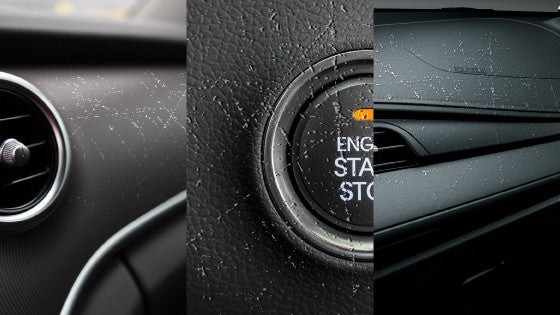Dogs and cars, a classic love story, right? But sometimes, that canine affection can leave unwanted marks on your vehicle, like a scratch across your dashboard. Whether it’s from playful paws, shifting cargo, or just everyday wear and tear, dashboard scratches are a common car owner woe. The good news is, you don’t have to live with them. Repairing scratches on your car dashboard is a DIY task you can tackle at home, saving you money and restoring your car’s interior appeal.
Regardless of your dashboard material – be it vinyl, plastic, leather, wood, or synthetic – scratches are a risk. This guide will walk you through the best methods to remove or minimize those unsightly marks, focusing on practical steps and effective techniques to bring your dashboard back to its pristine condition. We’ll cover everything from minor scuffs to deeper scratches, ensuring you have the knowledge to confidently restore your car’s interior.
Why Dashboard Scratch Repair Matters
Ignoring scratches on your dashboard isn’t just an aesthetic issue; it can impact your car’s overall value and long-term condition. Think of your dashboard like fine furniture – neglecting minor damage can lead to bigger problems down the road. Unattended scratches can deepen, discolor, and even develop hairline cracks over time. What starts as a small blemish can turn into a significant and costly repair if left untreated.
Moreover, those dashboard scratches silently chip away at your car’s resale value. Prospective buyers notice interior details, and a scratched dashboard sends a message of neglect, even if the damage is superficial. Whether your dashboard is plastic, leather, vinyl, or wood, scratches are universally recognized as a negative, reducing your vehicle’s appeal and market price.
Unlike exterior car scratches that can often be buffed out relatively easily, dashboard scratch repair demands a more nuanced approach. The interior materials are often more delicate and require specific techniques and products. Protecting your dashboard from scratches is always the best first step. Using interior protectants, waxes, or even dashboard covers can act as a barrier against daily wear and tear. Choosing a dash cover that fits your car model and reading customer reviews can help ensure you get a quality product that offers reliable protection.
Tools and Materials for DIY Dashboard Scratch Repair
Before you start repairing scratches, gathering the right tools and materials is crucial for a successful DIY project. Just like exterior car care requires specific products, dashboard repair has its own set of essentials. Forget household hacks like magic erasers or baking soda – for effective dashboard scratch repair, especially on plastic or vinyl, you’ll need specialized automotive products and tools. For minor surface scratches on black plastic or vinyl, a plastic restorer like Meguiar’s Ultimate Black Plastic Restorer and a microfiber cloth might suffice. However, for deeper scratches, a more comprehensive approach is necessary, requiring the following materials:
Recommended Materials for Plastic or Vinyl Dashboard Scratch Repair:
- Interior Car Cleaner: Opt for a high-quality, concentrated car interior cleaner. Spray bottles are particularly useful for dislodging dirt and debris from the scratch. While rubbing alcohol can be used in a pinch, a dedicated cleaner provides better results.
- Heat Gun or Hair Dryer: Heat is essential for making plastic and vinyl more pliable, allowing you to reshape the material and minimize the scratch.
- Fine Grit Sandpaper: Use fine grit sandpaper to gently smooth out imperfections and blend the repaired area seamlessly with the surrounding dashboard.
- Textured Automotive Finishing/Grain Pads: These pads are crucial for restoring the original texture to “leather-like” vinyl dashboards. Select a pad with a texture that closely matches your dashboard for a natural-looking repair. Various textures and patterns are available, so take your time to find the best match.
- Lint-Free Gloves: Protect your hands from heat and chemicals, and prevent skin oils from transferring to the dashboard. Nitrile gloves are a good choice.
- Color-Matched Paint (Optional): For dashboards with discoloration, color-matched paint designed for interior plastics can help restore a uniform appearance.
- Cleaning Cloths (Microfiber): Microfiber cloths are ideal for cleaning and wiping down surfaces without scratching.
Materials to Avoid When Repairing Dashboard Scratches:
Certain household items and tools can cause further damage to your dashboard. Avoid using the following:
- Household Cleaners: These are often too harsh for car interiors and can cause discoloration or damage to dashboard materials.
- Blow Torch: Excessive heat can easily melt or warp your dashboard. Use a heat gun or hairdryer on a low setting for controlled heating.
- Coarse Sandpaper: Aggressive sandpaper will worsen scratches. Always use fine grit sandpaper for delicate dashboard surfaces.
- Low-Temperature Finishing Media: Ensure your finishing pads are heat-resistant. Low-quality pads can melt and stick to the dashboard when heated.
- Spray Paint: Spray paint is difficult to control and can overspray onto unwanted areas. Use a brush and bottle for precise paint application if needed.
Step-by-Step Guide: Repairing Scratches on a Vinyl Dashboard
Repairing scratches on a vinyl dashboard involves a series of careful steps to ensure a seamless and professional-looking finish. Follow this detailed guide:
Step 1: Thorough Cleaning
Start by thoroughly cleaning the scratched area. Regardless of the dashboard material or any existing protective coatings like ceramic coating, cleaning is paramount. Use an interior cleaner spray and a microfiber cloth to remove all dirt, dust, and debris. This ensures a clean working surface and prevents discoloration during the repair process. Allow the area to dry completely before proceeding.
Step 2: Smoothing the Scratch
Examine the scratch for any raised edges or ridges of vinyl. These are common as the material is displaced when scratched. Gently use fine grit sandpaper to carefully smooth down these ridges. For larger ridges, you can cautiously use a razor blade or an Exacto knife to shave them off, holding the blade parallel to the dashboard surface. Exercise extreme caution to avoid causing further damage. After removing larger ridges, refine the area with fine grit sandpaper to make the scratch edges as flush as possible with the surrounding dashboard.
Step 3: Applying Heat
Using a heat gun on a low setting or a hairdryer on high heat, gently warm the scratched vinyl area. The goal is to soften the vinyl, making it more malleable. Be extremely careful not to overheat the dashboard, as vinyl and plastic can warp easily under excessive heat. Heat the area until the textured surface starts to become slightly glossy, indicating the vinyl is softening.
Step 4: Texture Restoration
While the vinyl is still warm and pliable, firmly press a textured finishing pad onto the damaged area. The heat and pressure will help to close the scratch and transfer the texture of the pad to the softened vinyl, blending the repaired area with the surrounding dashboard.
Step 5: Cooling and Inspection
Allow the repaired area to cool and harden completely. This step is crucial for the vinyl to regain its shape and texture. Once cooled, inspect the repair closely. Assess if the scratch is sufficiently minimized and if the texture matches the surrounding area. If needed, you can repeat steps 3 and 4 for further refinement.
Step 6: Final Touches
Once you are satisfied with the scratch repair, use superfine sandpaper to gently buff out any remaining imperfections. This will ensure a smooth and even surface. Wipe down the area with rubbing alcohol or interior cleaner to remove any sanding debris. If color discoloration is present, carefully apply color-matched paint to blend the repaired area seamlessly. Finally, consider applying a clear coat for added protection and a uniform finish.
Repairing Scratches on a Leather Dashboard
Leather dashboards require a different approach compared to vinyl or plastic. For minor surface scuffs on leather, a leather restoration wax or spray and a microfiber cloth may be enough. However, deeper scratches necessitate more specialized leather repair techniques. Modern leather repair kits have simplified the process, offering effective solutions without the need for traditional heating tools. These kits, like those from Fortivo, often provide a wider range of color options and user-friendly instructions. While leather repair can be more time-consuming than vinyl repair, the results can be excellent with the right products and techniques.
Step-by-Step Leather Dashboard Scratch Repair
Step 1: Cleaning and Preparation
Clean the scratched leather area with a leather cleaner or rubbing alcohol to remove dirt and debris. Carefully trim any loose or rough edges around the scratch using a razor blade or Exacto knife, moving parallel to the dashboard surface to avoid further damage.
Step 2: Color Matching
Leather repair kits typically include color mixing guides and a range of color pigments. Carefully follow the guide to mix a color that closely matches your dashboard. Test the mixed color in an inconspicuous area, such as under the glove box or on a lower door panel, and let it dry completely to ensure a good color match.
Step 3: Applying Filler Compound
Using the putty knife or applicator provided in the kit, apply the filler compound into the scratch. For deep scratches, a backing pad might be necessary to provide support for the filler. If possible, insert a backing pad into the scratch to make filling easier. Apply the filler compound in layers, allowing each layer to dry slightly before adding more. Once the scratch is filled, use a paintbrush to spread the excess filler and create a smooth, uniform surface. Clean up any excess filler with a paper towel.
Step 4: Drying Time
Allow the filler compound to dry completely according to the kit’s instructions. Drying times vary depending on the product, temperature, and humidity. Avoid rushing this step, as proper drying is essential for a durable repair. You can use a hairdryer on a low, cool setting to expedite drying, but avoid overheating the filler.
Step 5: Blending and Buffing
Once the filler is fully dry, use a Q-tip dampened with rubbing alcohol to gently blend the edges of the repaired area with the surrounding leather. Use circular motions to smooth out any unevenness and create a seamless transition. Inspect the repair and, if necessary, repeat steps 3 and 4 to add more filler for deeper scratches.
Step 6: Polishing and Protection
After achieving a smooth and blended repair, polish the leather dashboard with a leather conditioner or protectant. For enhanced protection against future scratches and damage, consider applying a ceramic coating specifically designed for leather surfaces. This will not only protect the repaired area but also maintain the overall appearance of your leather dashboard, keeping it looking its best for years to come.
By following these detailed steps for both vinyl and leather dashboards, you can effectively repair scratches and maintain the value and appearance of your car’s interior. With the right tools, materials, and a little patience, you can achieve professional-quality results at home.


